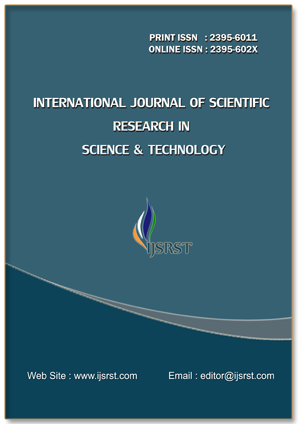Inspecting the Occurrence of Fungi In Rhizospheric Soil From Irrigated And Non-Irrigated Maize Crop Fields In Sillod Taluka
DOI:
https://doi.org/10.32628/IJSRST24114121Keywords:
Nutrients, Interaction, Rhizosphere, Irrigation, Rhizodeposition, Microbial Activity, MicroorganismsAbstract
Soil is the chief medium for the growth of the crops as well as the absorption of nutrients by roots and hence, only good quality soil has the ability to grow good quality crops. In the soil-plant interaction, the soil microbial communities are actively participating in the biomass and energy flow of the ecosystem and is considered as the most active component of soil ecosystem affected by a range of factors, such as irrigation systems, planting patterns, soil type and climatic changes. Irrigation is one of the most important factor of them. The rhizosphere of a plant root occupies a portion of soil that extends from the root to a non-defined extent in the soil that normally depends upon the diffusion of root secretions and the stage of development of the roots under the soil. Rhizosphere has very extreme amount of readily degradable carbon compounds and other nutrients made available by the rhizodepositions.
Downloads
References
Aneja K. R. (2003). Experiments in Microbiology. Plant Pathology and Biotechnology New age International Publication.
Barriuso, J., Solano B.R, Lucas J.A., Lobo A.P., Villaraco, A.G., Manero, F.J.C. (2008). Ecology, genetic diversity and screening strategies of plant growth promoting rhizobacteria (PGPR) In: Ahmad I, Pitchel J, Hayat S (eds) Plant bacteria interactions: Strategies and techniques to promote plant growth. Wiley-VCH Verlag GmbH and co. KGaA, Weinheim, pp 1-17. DOI: https://doi.org/10.1002/9783527621989.ch1
Chenu, C., and Stotzky. G. (2002). Interactions between microorganisms and soil particles: an overview. In: Interactions between soil and particles and microorganisms, 205- 218.
Doran, J.W. (2005). In-Field Measurement of Soil Quality and Sustainable Management. In 2005.
Wisconsin Fertilizer, Aglime, and Pest Management Conference, Alliant Energy Center, Madison, Wisconsin, January 18–20, Laboski C and Boerdoom C (eds) University of Wisconsin Extension: Madison, Wisconsin, 44: 27–31.
Gerhardson, B., Alstrom, S., Ramert, B. (1985).Plant reactions to ¨ inoculation of roots with fungi and bacteria. Phytopathologische Zeitschrift 114, 108–117. DOI: https://doi.org/10.1111/j.1439-0434.1985.tb00832.x
Hinsinger, P., Gobran, G.R., Gregory, P.J., Wenzel, W.W. (2005). Rhizosphere geometry and heterogenity arising from root-mediated physical and chemical processes. New Phytologist 168, 293–303. DOI: https://doi.org/10.1111/j.1469-8137.2005.01512.x
Jenkinson, D.S., and Ladd, J.N. (1981). Microbial biomass in soil: measurement and turnover. In: Paul, E.A. and Ladd, J.N. (eds). Soil Biochemistry. Vol. 5 Marcel Deccker, Inc, New York and Basel, pp. 415-471.
Kiran Singh., Jaishree Borana., and Sobha Srivastava, V.A. (1999). Journal of soil biology and ecology. 19, 11-14.
Lynch, J.M. (1987). some consequences of microbial rhizosphere competence for plant and soil. In: Lynch JM(ed) The rhizosphere. Wiley Inter-science, New York, pp 1-10.
Massaccesi, L., Benucci, G.M.N., Gigliotti, G., Cocco, S., Corti, G., and Agnelli, A. (2015). Rhizosphere effect of three plant species of environment under periglacialconditions (Majella Massif, central Italy). Soil Biology and Biochemistry, 89: 184-195. DOI: https://doi.org/10.1016/j.soilbio.2015.07.010
Nagamani, A, Kunwar, I. K, Manoharachary. C. (2006). Handbook of soil fungi. I. K. International pvt. Ltd., New Delhi.
Raaijmakers, J.M. (2001).Rhizosphere and rhizosphere competence. In: Maloy OC, Murray TD (eds) Encyclopedia of plant pathology. Wiley, USA, pp 859–860. DOI: https://doi.org/10.1002/047126363X.agr325
Sorensen, J., Nicolaisen, M.H., Ron, E., and Simonet, P. (2009). Molecular tools in rhizosphere microbiology-from single-cell to whole-community analysis. Plant Soil 321: 483–512. DOI: https://doi.org/10.1007/s11104-009-9946-8
Uren, N.C. (2001).Types, amounts and possible functions of compounds released into the rhizosphere by soil-grown plants. In: Pinton R, Varanini Z, Nannipieri P (eds) The rhizosphere biochemistry and organic substances at the soil-plant interface. Marcel Dekker, New York, pp 19– 40 .
Watanabe, T. (2010). Pictorial atlas of soil and seed fungi: morphologies of cultured fungi and key to species (CRC press).
Whipps, J.M., Lynch, J.M. (1985). Energy losses by the plant in rhi-zodeposition. Ann Proceedings Phytochem J Eur 26:59–7.
Lin, S., Zhuang, J.Q., Chen, T., Zhamg, A.J., Zhou, M.M., and Lin, W.X. (2012). Analysis of nutrient and microbial Biolog function diversity in tea soils with different planting years in Fujian Anxi. Chinese Journal of Eco-Agriculture 20: 1471−1477. DOI: https://doi.org/10.3724/SP.J.1011.2012.01471
Lynch, J.M. (1987). some consequences of microbial rhizosphere competence for plant and soil. In: Lynch JM(ed) The rhizosphere. Wiley Inter-science, New York, pp 1-10.
Lynch, J. (1990). the rhizosphere. Wiley, London, UK, p 458.
Downloads
Published
Issue
Section
License
Copyright (c) 2024 International Journal of Scientific Research in Science and Technology

This work is licensed under a Creative Commons Attribution 4.0 International License.
https://creativecommons.org/licenses/by/4.0





